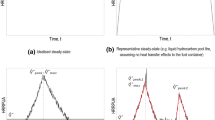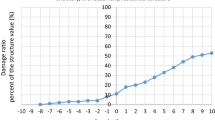Abstract
The basic structure of historic sites and their associated interior artefacts can be damaged or even destroyed by climate change. The evaluation of combined heat and moisture induced stress and strain (HMSS) can predict possible damage-related processes. In this paper, the development of one- and two-dimensional HMSS models of building materials and artefacts in COMSOL Multiphysics Version 4, a commercial finite element software, is presented. The validation of the numerical models is revealed using analytical, numerical and experimental solutions. As a result, the HMSS model was shown to be an adequate predictive tool to determine possible damage-related processes in building assemblies and artefacts.
Similar content being viewed by others
References
Bratasza L, Harris I, Lasyk L, Łukomski M, Kozłowski R (2012). Future climate-induced pressures on painted wood. Journal of Cultural Heritage, 13: 365–370.
Burke S (2009). Building Physics Tools: Needs, Use and the Lack of Use in the Building Process. Modeling Non-isothermal Moisture Flow and Frost Penetration. PhD Thesis, Lund University of Technology, Sweden.
Castellini P, Esposito E, Marchetti B, Paone N, Tomasini EP (2003). New applications of Scanning Laser Doppler Vibrometry (SLDV) to non-destructive diagnostics of artworks: Mosaics, ceramics, inlaid wood and easel painting. Journal of Cultural Heritage, 4: 321–329.
Claesson J (2002). Boltzmann solution of coupled nonlinear equations for moisture content w(s) and temperature T(s), s=x/root(4t). Benchmark test I, Chalmers University of Technology, Sweden.
COMSOL (2010). COMSOL Multiphysics Version 4.1. COMSOL AB.
Dardes K, Rothe A (1995). The Structural Conservation of Panel Paintings. In: Proceedings of a symposium at the J. Paul Getty Museum, Los Angeles US. Available: http://www.getty.edu/conservation/publications/pdf_publications/panelpaintings3.pdf.
Dionisi Vici P, Mazzanti P, Uzielli L (2006). Mechanical response of wooden boards subjected to humidity step variations: Climatic chamber measurements and fitted mathematical models. Journal of Cultural Heritage, 7: 37–48.
Eschenauer H, Olhoff N, Schnell W (1997). Applied Structural Mechanics. Berlin: Springer-Verlag.
Fraunhofer Institut für Bauphysik (IBP) Holzkirchen (2010). WUFI 2D Version 3.3.
Hagentoft C-E (1998). The impact of heat, air and moisture transport on energy demand and durability, Final report. International Energy Agency Annex 24. Task 5: Performances and Practice.
Hagentoft C-E (2011). Introduction to Building Physics. Lund, Sweden: Studentlitteratur.
Hagentoft C-E (2002). HAMSTAD-WP2 Modeling, Report R-02:9. Chalmers University of Technology, Sweden.
Huijbregts Z, Kramer RP, Martens MHJ, van Schijndel AWM, Schellen HL (2012). A proposed method to assess the damage risk of future climate change to museum objects in historic buildings. Building and Environment, 55: 43–56.
Huijbregts Z, Kramer RP, van Schijndel AWM, Schellen HL (2011). Computational modeling of the impact of climate change on the indoor environment of a historic building in the Netherlands. In: Proceedings of 9th Nordic Symposium on Building Physics, Tampere, Finland, pp. 833–840.
International Institute of Conservation (ICA) (2010). The Plus/Minus Dilemma: The Way Forward in Environmental Guidelines-Edited transcription of the roundtable. Available: http://www.iiconservation.org/dialogues/Plus_Minus_trans.pdf.
Jacob D, Podzun R (1997). Sensitivity studies with the regional climate model REMO. Meteorology Atmospheric Physics, 63: 119–129.
Jakieła S, Bratasz Ł, Kozlowski R (2008). Numerical modeling of moisture movement and related stress field in lime wood subjected to changing climate conditions. Wood Science and Technology, 42: 21–37.
James C, Simonson CJ, Talukdar P, Roels S (2010). Numerical and experimental data set for benchmarking hygroscopic buffering models. International Journal of Heat and Mass Transfer, 53: 3638–3654.
Janssen H (2011). Thermal diffusion of water vapour in porous materials: Fact or fiction? International Journal of Heat and Mass Transfer, 54: 1548–1562.
Kowalkski SJ, Rybicki A (2004). Drying induced stresses in a swelling porous wall. Journal of Transport in Porous Media, 57: 35–48.
Kowalski SJ, Smoczkiewicz-Wojciechowska A (2007). Stresses in dried wood. Modeling and experimental identification. Transport in Porous Media, 66: 145–158.
Łukomski M (2012). Painted wood. What makes the paint crack? Journal of Cultural Heritage, 13(Supplement): s90–s94.
Marcon B, Mazzanti P, Uzielli L, Cocchi L, Dureisseix D, Gril J (2012). Mechanical study of a support system for cupping control of panel paintings combining crossbars and springs. Journal of Cultural Heritage, 13(Supplement): s109–s117.
Martens MHJ (2012). Climate Risk Assessment in Museums. PhD Thesis, Eindhoven University of Technology, the Netherlands.
Mazzanti P, Togni M, Uzielli L (2012). Drying shrinkage and mechanical properties of poplar wood (Populusalba L.) across the grain. Journal of Cultural Heritage, 13(Supplement): s85–s89.
Mihoubi D, Bellagi A (2009). Stress generated during drying of saturated porous media. Journal of Transport in Porous Media, 80: 519–536.
Mirianon F, Fortino S, Toratti T. (2008). A method to model wood by using ABAQUS finite element software. Part 1. Constitutive model and computational details. VTT Technical Research Centre of Finland, VTT Publications 687.
Mortensen LH, Rode C, Peuhkuri R (2008). Investigation of airflow patterns in a microclimate by particle image velocimetry (PIV). Building and Environment, 43: 1929–1938.
Nicolai A, Grunewald J, Zhang JS. (2007). Salt mixture transport and phase transitions, Modeling and numerical solution in Delphin 5. In: Proceedings of 12th Symposium for Building Physics, Dresden, Germany.
Ottosen N, Petersson H (1992). Introduction to the Finite Element Method. Harlow, UK: Pearson/Prentice Hall.
prEN 15026 (2004). European Provisional Standard prEN 15026: Hygrothermal Performance of Building Components and Building Elements-Assessment of Moisture Transfer by Numerical Simulation.
Rachwał B, Bratasz Ł, Łukomski M, Kozłowski R (2010). Response of wood supports in panel paintings subjected to changing climate conditions. Strain, 48: 366–374.
Sasic Kalagasidis A, Bednar T. Hagentoft C-E (2004). The evaluation of the interface moisture conductivity between control volumes: Comparison between linear, harmonic and integral averaging. In: Proceedings of 9th International Conference on Performance of the Exterior Envelopes of Whole Buildings, Clearwater Beach.
Schellen HL, van Schijndel AWM (2011). Setpoint control for air heating in a church to minimize moisture related mechanical stress in wooden interior parts. Building Simulation, 4: 79–86.
van Schijndel AWM (2011). Multiphysics modeling of building physical constructions. Building Simulation, 4: 49–60.
Segerholm I (2007). Moisture Transport Processes in Scots Pine-Anomalous Capillary Suction, Nonisothermal Diffusion. PhD Thesis, Chalmers University of Technology, Sweden.
Sevilgen G, Kilic M (2011). Numerical analysis of air flow, heat transfer, moisture transport and thermal comfort in a room heated by two-panel radiators. Energy and Buildings, 43: 137–146.
Williams Portal N (2011). Evaluation of heat and moisture induced stress and strain of historic building materials and artefacts. Master Thesis, Chalmers University of Technology, Sweden.
Williams Portal N, Sasic Kalagasidis A, van Schijndel AWM (2011). Simulation of heat and moisture induced stress and strain of historic building materials. In: Proceedings of 12th IBPSA International Conference, Sydney, Australia.
Woloszyn M, Rode C (2008). Tools for performance simulation of heat, air and moisture conditions of whole buildings. Building Simulation, 1: 5–24.
Author information
Authors and Affiliations
Corresponding author
Rights and permissions
About this article
Cite this article
Portal, N.W., van Schijndel, A.W.M. & Kalagasidis, A.S. The multiphysics modeling of heat and moisture induced stress and strain of historic building materials and artefacts. Build. Simul. 7, 217–227 (2014). https://doi.org/10.1007/s12273-013-0153-4
Received:
Revised:
Accepted:
Published:
Issue Date:
DOI: https://doi.org/10.1007/s12273-013-0153-4




